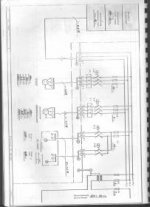Hi,
I am trying to operate a piece of equipment that was designed for use in Europe in the United States. The equipment is known as a fluidized bed and consists of a turbine, a pump and two heating elements. The turbine and the pump are designed to be operated using 3 phase 380 V, 50 Hz power. The heating elements are wired in such a way that they operate using single phase 280 V, 50 Hz power. I have attached the electrical schematic of the fluidized bed to this posting.
My electrical supply in the US is 3 phase 480 V, 60 Hz and I have considered a number of options for running the machine in our facility. I contacted one company that designs rotary phase converters, they suggested that 480 V, 60 Hz was equivalent to 380 V, 50 Hz and that I did not need a phase converter to run the instrument. They had not seen the electrical diagram, but some electrical engineers who looked at the diagram suggested that 480 V, 60 Hz would probably not work. They are worried that the control elements, which are not shown in the electrical schematic, could be operating off of the line frequency.
I also contacted three different VFD manufacturers. Two of them believe that they can convert 480 V- 60 Hz to 380 V-50 Hz, but they believe that the presence of the single phase heating elements operating off of 220 V will cause the VFDs to shut down. A third VFD manufacturer has described a custom solution for the problem, but I do not understand the proposal. They want to make a VFD that operates using 220 V input, but creates 380 V output at 50 Hz. They think that this will prevent the VFD from shutting down. I don't really understand enough about electricity to evaluate this proposal. In order to operate the VFD, do I need to convert our 480 V, 60 Hz to 220V single phase. How will that prevent the VFD from shutting down?
I would appreciate any insight into the best way to handle the issue. Replacing the pump, turbine and heating elements is not a very convenient option. Is the custom VFD proposal promising?If not, any direction would be greatly appreciated.
https://drive.google.com/file/d/0B3RbBMxUS0_hc3VqWTdHbEZvOVU/view?usp=sharing

I am trying to operate a piece of equipment that was designed for use in Europe in the United States. The equipment is known as a fluidized bed and consists of a turbine, a pump and two heating elements. The turbine and the pump are designed to be operated using 3 phase 380 V, 50 Hz power. The heating elements are wired in such a way that they operate using single phase 280 V, 50 Hz power. I have attached the electrical schematic of the fluidized bed to this posting.
My electrical supply in the US is 3 phase 480 V, 60 Hz and I have considered a number of options for running the machine in our facility. I contacted one company that designs rotary phase converters, they suggested that 480 V, 60 Hz was equivalent to 380 V, 50 Hz and that I did not need a phase converter to run the instrument. They had not seen the electrical diagram, but some electrical engineers who looked at the diagram suggested that 480 V, 60 Hz would probably not work. They are worried that the control elements, which are not shown in the electrical schematic, could be operating off of the line frequency.
I also contacted three different VFD manufacturers. Two of them believe that they can convert 480 V- 60 Hz to 380 V-50 Hz, but they believe that the presence of the single phase heating elements operating off of 220 V will cause the VFDs to shut down. A third VFD manufacturer has described a custom solution for the problem, but I do not understand the proposal. They want to make a VFD that operates using 220 V input, but creates 380 V output at 50 Hz. They think that this will prevent the VFD from shutting down. I don't really understand enough about electricity to evaluate this proposal. In order to operate the VFD, do I need to convert our 480 V, 60 Hz to 220V single phase. How will that prevent the VFD from shutting down?
I would appreciate any insight into the best way to handle the issue. Replacing the pump, turbine and heating elements is not a very convenient option. Is the custom VFD proposal promising?If not, any direction would be greatly appreciated.
https://drive.google.com/file/d/0B3RbBMxUS0_hc3VqWTdHbEZvOVU/view?usp=sharing

Last edited:

